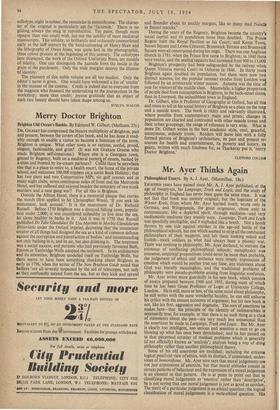Merry Doctor Brighton
Brighton Old Ocean's Bauble. By Edmund W. Gilbert. (Methuen. 25s.) DR. GILBERT has compressed the bizarre multiplicity of Brighton, past and present, between the covers of his book, and he has done it read- ably enough to enable a visitor to become a historian of the town. Brighton is unique. What other town is so various, sordid, proud, elegant, fashionable, and grim? (It was not Graham Greene who made Brighton self-conscious.) Where else is a Georgian town, graced by Regency, built on a medieval pattern f streets, backed by a slum and fronted by ice-cream parlours? Could there be anywhere else that is a place to retire to, a health resort, the home of the private school, and welcomes 100,000 trippers on.,a sunlit Bank Holiday; that has two piers and two Conservative MPs, six golf courses and as many night clubs, seven continuous miles of front and the Metropole Hotel, and has suffered and enjoyed besides the notoriety of two trunk murders and a race gang war? For all this is Brighton.
Outside the Albion Hotel, there is a memorial plaque that carries the words (first applied to Sir Christopher Wren), 'If you seek his monument, look around.' It is the monument of Dr. Richard Russell. Before 1750 Brighton was a decayed fishing town, popula- tion under 2,000; it was considered unhealthy to live near the sea, let alone healthy • to bathe in it. And it was in 1750 that Russell published De Tabe Glandulari De Usu Marine in Morbis Glandularum Dissertatio under the Oxford imprint, decreeing that' the omniscient creator of all things had designed the sea as a kind of common defence against the corruption and putrefaction of bodies.' and recommending not only bathing in it, and its air, but also drinking it. The treatment was a social success, and patients who had previously favoured Bath, Epsom or Tunbridge Wells adopted the seaboard. In its architecture and its amenities, Brighton modelled itself on Tunbridge Wells, but there seems to have been something shocking about Brighton as early as 1796, when the writer of The New Brighton Guide noted that bathers are all severely inspected by the aid of telescopes, not only as they confusedly ascend from the sea, but as they kick and sprawl and flounder about its muddy margins, like so many mad Naiads in flannel smocks.
During the years of the Regency, Brighton became the country's social capital and its population more than doubled. The Prince Regent built the Royal' Pavilion as his Court; and Kemp Town, Sussex Square and Lewes Crescent, Brunswick Terrace and Brunswick Square were all constructed during his reign. There was one Anglican church in 1783, when the Prince first came to Brighton; in 1840 there were twelve, and the seating capacity had increased from 900 to 13,000 Brighton's prosperity had been safeguarded by the railway when Queen Victoria moved Court to Osborne in 1846. In thirty years Brighton again doubled its population, but there were now twO distinct seasons, for the popular summer exodus from London wa4 followed by an aristocratic winter season. Autumn was the time of year for visitors of the middle class. Meanwhile, a higher proportion of people died from consumption in Brighton, in the back-street slums, than in Liverpool, the unhealthiest town in England.
Dr. Gilbert, who is Professor of Geography at Oxford, has all this and more to tell in his social history of Brighton as a place on the map and a seaside town. The book is richly and relevantly illustrated, where possible from contemporary maps and prints; changes in population are charted and contrasted with other seaside towns and their urban groupings; the range of reference is very wide. What is more Dr. Gilbert writes in the best academic style, cool, graceful, anonymous, sedately ironic. Readers will leave him with a fully formed picture of Brighton's architecture, its past and present re• sources for health and entertainment, its poverty and luxury, its gaiety, written with much fondness for, as Thackeray put it, 'merry Doctor Brighton.'
CLIFFORD COLLINS


































 Previous page
Previous page